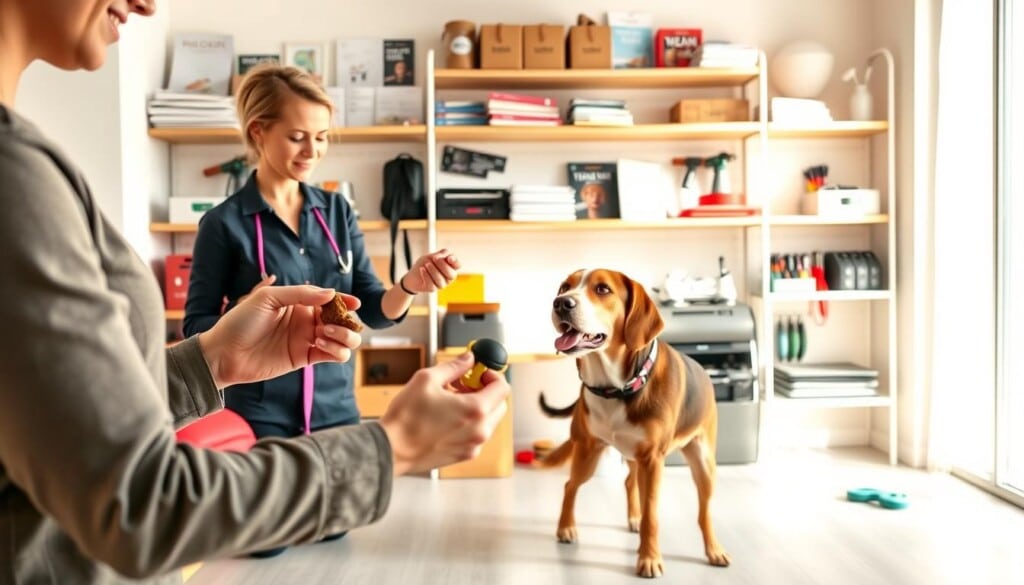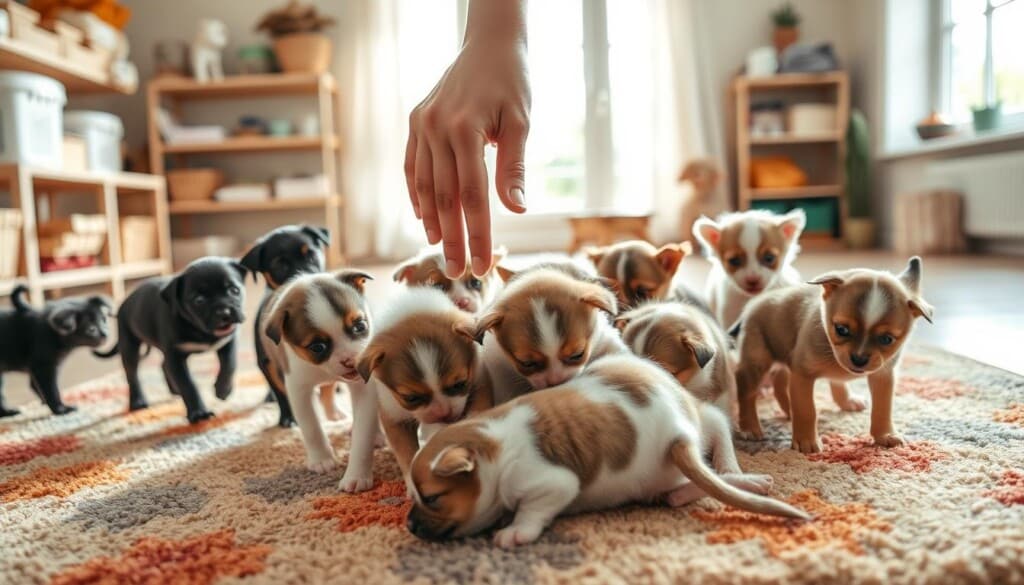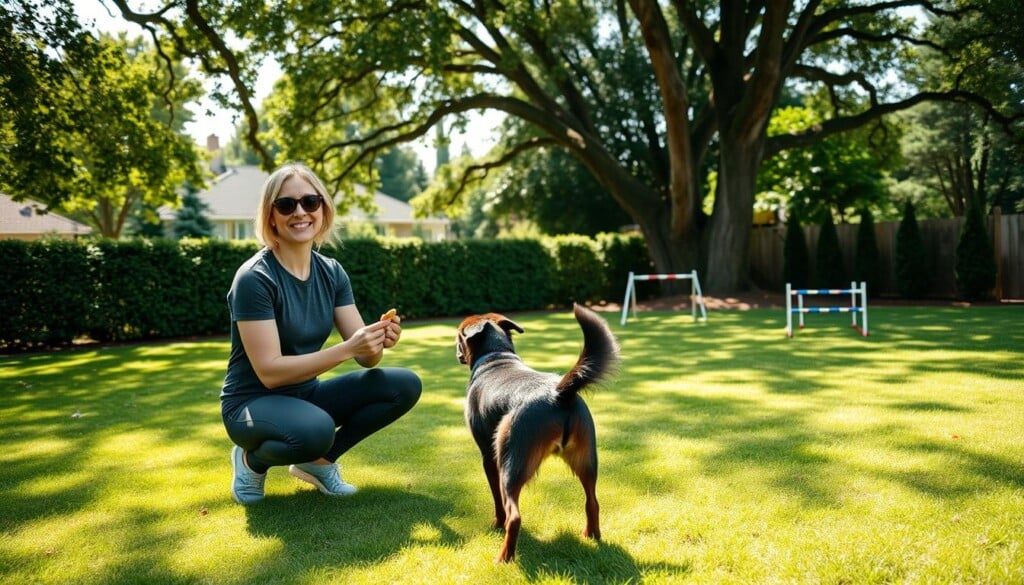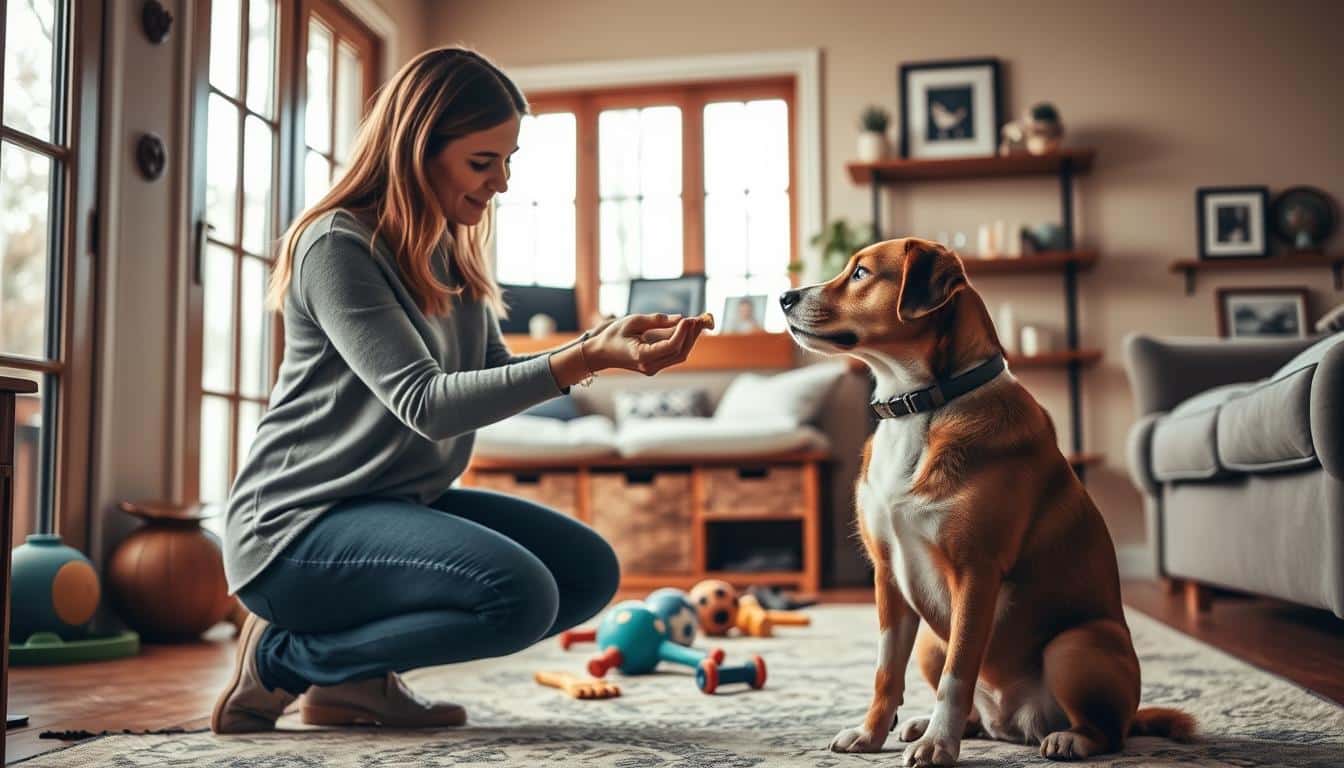Ever wondered why some pets seem to get commands right away, while others don’t? It’s all about the right training techniques. These methods not only improve dog obedience but also make life better for both pets and owners. Training brings many benefits, like better behavior and safety, and strengthens the bond between pets and their people.
This article will explore the basics of pet training. We’ll see why positive reinforcement is key to lasting success.
Explore cat behavior training and learn how to make your pets well-behaved. With the right training, your pets can have a brighter, more disciplined future.
Key Takeaways
- Understanding the basics of pet training offers many advantages.
- Positive reinforcement is essential for effective dog training.
- Knowing and debunking pet training myths can improve results.
- Cat behavior training is also vital for a peaceful home.
- Sticking to one training method builds trust and strengthens bonds.
Understanding the Basics of Pet Training
Effective pet training is key to a well-mannered and safe home for pets and their owners. It’s more than just teaching commands. It helps pets and their families communicate better and strengthens their bond. Training also solves behavioral issues that pets might have if not guided right.
Importance of Training Your Pet
Regular pet training brings many benefits. It teaches discipline and improves social behavior. It also prevents problems like aggression or anxiety. Learning dog training basics makes for a happier home.
Training sessions build respect and understanding between pets and their owners. This is vital for a healthy relationship.
Common Myths About Pet Training
Many myths about pet training confuse owners and make training harder. One myth is that training is only for pets with problems. But all pets need to learn basic commands and manners.
Another myth is that anyone can train a dog without help. This can lead to frustration and poor results. Getting professional help is key to successful training and debunking these myths.
Choosing the Right Training Method
Choosing the right training method is key for successful pet training. There are many methods, each with its own way of teaching good behavior. Positive reinforcement training is popular because it rewards good actions instead of using fear or punishment.
This approach helps build a strong bond between pet and owner. It makes learning fun. On the other hand, using punishment can confuse and scare pets. This can harm their well-being.
Positive Reinforcement vs. Punishment
Positive reinforcement training rewards pets for good behavior right away. This can be through praise, treats, or play. It shapes behavior well without the negative effects of punishment.
Punishment, on the other hand, can cause stress or fear. It’s important for owners to think about the long-term effects of their training methods.
Clicker Training: What You Need to Know
Clicker training is a special part of positive reinforcement. It uses a clicker to mark when a pet does something right. This is followed by a reward, helping pets understand better.
This method gives pets immediate feedback. It helps them connect their actions with rewards. For more on pet training, check out LocalZ.

Essential Commands Every Pet Should Learn
Teaching essential pet commands is key to a well-behaved pet. Basic commands like “sit,” “stay,” and “come” help owners communicate with their pets. These commands promote good behavior and safety, making pets more responsive.
Sit, Stay, and Come
“Sit,” “stay,” and “come” are basic commands every pet should know. Learning to sit helps manage pets in busy places. “Stay” adds control, keeping pets in one spot until told to move.
The “come” command is vital for safety, mainly when pets are off-leash. Regular practice of these commands builds a strong obedience foundation.
Leash Training for Dogs
Leash training is essential for dogs. It helps stop pulling, making walks smoother. A well-trained dog walks nicely on a leash, staying by its owner’s side.
Adding leash training to walks strengthens the bond between pet and owner. It also improves behavior outside the home. These skills make walks better for both pets and their owners.
The Role of Socialization in Pet Training
Pet socialization is key to good training. It involves exposing pets to different places and situations. This helps them avoid anxiety and become well-adjusted friends.
Training in new places helps pets get used to various things. It’s important for their growth and development.
Introducing Your Pet to New Environments
Start by slowly introducing pets to new places. Begin with quiet spots and then move to busier areas. Positive rewards help them explore without fear.
Keep training sessions short and fun. This makes them eager to face new challenges.
Meeting Other Pets and People
Introducing pets to other animals and people is very helpful. Controlled meetings teach them good behavior and build confidence. It’s important to watch their body language.
Regular social interactions help pets learn to interact well. It reinforces the importance of socialization.

Addressing Behavioral Issues
Understanding and managing pet behavioral issues is key for a peaceful home. This section covers common problems like excessive barking, destructive chewing, and annoying dog jumping. It offers practical solutions and insights into their causes. Knowing what triggers these behaviors helps in training pets to behave better.
Barking, Chewing, and Jumping
Excessive barking often comes from boredom, anxiety, or a need for attention. To solve this, owners should first figure out why their pets bark. Playing with them or giving them stimulating toys can help. Dog jumping usually means they’re excited or too active. Teaching them to greet calmly and using commands like “sit” can help control this.
Aggression Management Strategies
Aggressive behavior in pets is a big challenge for owners. Aggression training aims to understand the reasons behind it, like fear or past trauma. It uses gradual exposure to triggers and positive reinforcement for good behavior. Getting help from certified trainers can make a big difference, making the environment safer for everyone.
Outdoor Training Tips for Pets
Outdoor pet training can greatly improve a pet’s learning and well-being. Local parks are perfect for obedience training, with lots of space and different things to see and smell. This helps pets learn commands better in real-life situations.
Using Local Parks for Obedience Training
Training in parks should use the surroundings to your advantage. You can practice recall, heel, and sit-stay commands in open spaces. These exercises help pets learn obedience and get used to different sights, smells, and sounds.
Safety Precautions While Outdoors
When training pets outside, safety is key. Make sure your pet wears a secure collar with ID tags. Always use a strong leash, even in crowded places with other dogs and people. Stay alert to keep pets safe from dangers, like other animals. For extra help, find local trainers who can guide you in outdoor training.

Incorporating Training into Daily Routines
Adding training to your daily life is key for a well-behaved pet. Daily routines help pets learn better in a structured setting. This consistency leads to lasting changes in their behavior and makes training fun.
By making training a regular part of your day, you build a stronger bond with your pet. This is important for their happiness and your relationship with them.
Making Training Fun for Your Pet
Make training fun by turning it into playtime. Practice commands while playing, and reward good behavior with treats. Use toys or games to keep your pet’s mind active.
This approach makes training enjoyable for your pet. They will look forward to it, which helps them learn more eagerly.
Creating Consistent Training Schedules
Having a routine makes training easier for pets. They learn to expect training times. Try to fit training into your daily activities like feeding, walks, or play.
This way, training becomes a natural part of the day. It helps avoid overwhelming your pet. A structured schedule makes training enjoyable for both you and your pet.
Finding Local Pet Training Resources
Finding good local pet training resources is key for pet owners. It helps improve their pet’s behavior and their bond. Using platforms like LocalZ makes it easy to find professional trainers. It helps users find dog trainers near them who meet their needs.
This online directory makes it simple to compare different trainers. It helps pet owners find the best fit for their pets.
Using LocalZ to Connect with Trainers
LocalZ is a great tool for finding local services, including dog trainers. Users can search for trainers based on their preferences. It provides a wealth of information on trainers in the area.
This resource helps pet owners make smart choices. It highlights each trainer’s credentials, training style, and specialties.
Reading Reviews to Find the Best Fit
Reading reviews on LocalZ is very helpful. Feedback from other pet owners gives insights into trainers. It shows how well a trainer works with pets.
Reviews help users decide if a trainer is right for their pet. They ensure a good match for both pet and owner.
Evaluating Your Pet’s Progress
It’s key to watch how your pet is doing in training. This helps owners see if their efforts are working. By tracking progress, you can see how far your pet has come or where they need more work.
Keeping Track of Training Milestones
Writing down your pet’s training wins is helpful. It shows you what’s going well and what needs more focus. Keeping a record helps you see how your pet is improving. Experts say it’s important for planning future training.
When to Seek Professional Help
Even with good training, some pets might not change their ways. Knowing when to get help from a pro is important. If your pet’s bad habits don’t get better, a trainer can offer new ways to help.
Trainers have special skills to help pets and owners. They make sure training is a good experience for everyone.
Exploring Advanced Training Techniques
Advanced pet training introduces pets to new skills, boosting their physical and mental health. Agility training and therapy animal training are key areas. They offer unique benefits for pets and their owners.
Agility Training for Active Pets
Agility training is a thrilling activity for lively pets. It keeps them physically fit and strengthens the bond with their owners. Pets learn to navigate obstacle courses, improving their speed, coordination, and focus.
Agility training is a fun way for pets to burn off energy and stay in shape. It includes jumps, tunnels, and weave poles. This training requires pets to be mentally and physically sharp.
As pets progress, they become more confident and responsive. Owners see their pets’ behavior improve significantly.
Therapy Animal Training Basics
Therapy animal training prepares pets to offer emotional support in places like hospitals and schools. It teaches them to be calm and friendly in stressful situations. Therapy animals need to be sociable and patient.
They learn basic commands and how to handle different situations. This training makes them great companions for those in need. It brings joy and healing to both the animals and those they help.
Engaging with the Local Community
Joining local pet training groups has many benefits for pets and their owners. These groups let people share tips and experiences, helping pets get along better. It also helps owners learn new ways to improve their pets’ behavior.
Being part of these communities can make training more effective. It also helps build strong friendships between pet owners. Together, they can learn new techniques to better their pets’ skills.
Benefits of Local Pet Training Groups
Community pet training is a place where owners can talk about their pets’ progress. It’s a space filled with support and encouragement. This makes it a great place for pets to learn social skills and for owners to bond with their pets.
How LocalZ Supports Local Pet Businesses
LocalZ helps the local economy by connecting people with pet services and training. It promotes local businesses, making it easier for owners to find what they need. This platform improves the pet ownership experience and strengthens community bonds.

